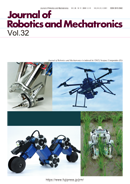32 巻, 1 号
選択された号の論文の26件中1~26を表示しています
- |<
- <
- 1
- >
- >|
Special Issue on Human-Robot Interaction in Close Distance
-
原稿種別: Editorial
2020 年32 巻1 号 p. 7
発行日: 2020/02/20
公開日: 2020/02/20
PDF形式でダウンロード (175K) -
原稿種別: Paper
2020 年32 巻1 号 p. 8-20
発行日: 2020/02/20
公開日: 2020/02/20
PDF形式でダウンロード (2074K) -
原稿種別: Paper
2020 年32 巻1 号 p. 21-31
発行日: 2020/02/20
公開日: 2020/02/20
PDF形式でダウンロード (870K) -
原稿種別: Paper
2020 年32 巻1 号 p. 32-42
発行日: 2020/02/20
公開日: 2020/02/20
PDF形式でダウンロード (586K) -
原稿種別: Paper
2020 年32 巻1 号 p. 43-50
発行日: 2020/02/20
公開日: 2020/02/20
PDF形式でダウンロード (1007K) -
原稿種別: Paper
2020 年32 巻1 号 p. 51-58
発行日: 2020/02/20
公開日: 2020/02/20
PDF形式でダウンロード (1363K) -
原稿種別: Paper
2020 年32 巻1 号 p. 59-67
発行日: 2020/02/20
公開日: 2020/02/20
PDF形式でダウンロード (1600K) -
原稿種別: Paper
2020 年32 巻1 号 p. 68-75
発行日: 2020/02/20
公開日: 2020/02/20
PDF形式でダウンロード (1219K) -
原稿種別: Paper
2020 年32 巻1 号 p. 76-85
発行日: 2020/02/20
公開日: 2020/02/20
PDF形式でダウンロード (778K) -
原稿種別: Paper
2020 年32 巻1 号 p. 86-96
発行日: 2020/02/20
公開日: 2020/02/20
PDF形式でダウンロード (1486K) -
原稿種別: Paper
2020 年32 巻1 号 p. 97-112
発行日: 2020/02/20
公開日: 2020/02/20
PDF形式でダウンロード (1201K) -
原稿種別: Paper
2020 年32 巻1 号 p. 113-127
発行日: 2020/02/20
公開日: 2020/02/20
PDF形式でダウンロード (4212K) -
原稿種別: Review
2020 年32 巻1 号 p. 128-135
発行日: 2020/02/20
公開日: 2020/02/20
PDF形式でダウンロード (896K)
Special Issue on Wearable Robotics and Mechatronics Technology
-
原稿種別: Editorial
2020 年32 巻1 号 p. 137
発行日: 2020/02/20
公開日: 2020/02/20
PDF形式でダウンロード (210K) -
原稿種別: Paper
2020 年32 巻1 号 p. 138-148
発行日: 2020/02/20
公開日: 2020/02/20
PDF形式でダウンロード (2486K) -
原稿種別: Paper
2020 年32 巻1 号 p. 149-156
発行日: 2020/02/20
公開日: 2020/02/20
PDF形式でダウンロード (695K) -
原稿種別: Paper
2020 年32 巻1 号 p. 157-172
発行日: 2020/02/20
公開日: 2020/02/20
PDF形式でダウンロード (6770K) -
原稿種別: Paper
2020 年32 巻1 号 p. 173-182
発行日: 2020/02/20
公開日: 2020/02/20
PDF形式でダウンロード (819K) -
原稿種別: Paper
2020 年32 巻1 号 p. 183-198
発行日: 2020/02/20
公開日: 2020/02/20
PDF形式でダウンロード (1371K) -
原稿種別: Paper
2020 年32 巻1 号 p. 199-208
発行日: 2020/02/20
公開日: 2020/02/20
PDF形式でダウンロード (2016K) -
原稿種別: Paper
2020 年32 巻1 号 p. 209-219
発行日: 2020/02/20
公開日: 2020/02/20
PDF形式でダウンロード (2506K)
Special Issue on Activity of Research Center - Tokyo Metropolitan University: Community-centric System Research Center
-
原稿種別: Institute Overview
2020 年32 巻1 号 p. 222-223
発行日: 2020/02/20
公開日: 2020/02/20
PDF形式でダウンロード (142K) -
原稿種別: Paper
2020 年32 巻1 号 p. 224-235
発行日: 2020/02/20
公開日: 2020/02/20
PDF形式でダウンロード (2259K) -
原稿種別: Paper
2020 年32 巻1 号 p. 236-243
発行日: 2020/02/20
公開日: 2020/02/20
PDF形式でダウンロード (1545K)
Regular Papers
-
原稿種別: Paper
2020 年32 巻1 号 p. 245-253
発行日: 2020/02/20
公開日: 2020/02/20
PDF形式でダウンロード (6378K) -
原稿種別: Paper
2020 年32 巻1 号 p. 254-263
発行日: 2020/02/20
公開日: 2020/02/20
PDF形式でダウンロード (1599K)
- |<
- <
- 1
- >
- >|
